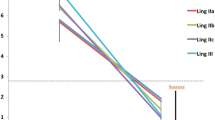Abstract
Background and aims
Peroral endoscopic myotomy (POEM) is a promising endoscopic technique for achalasia. We aimed to establish a regression model and develop a simple nomogram to predict the technical difficulty of POEM in a single center with large volume cases.
Methods
3385 achalasia patients treated with POEM were included, and the technical difficulty was systemically evaluated. All of them were randomized into the training cohort (n = 1693) or internal validation cohort (n = 1692). Then, the prediction model and nomogram were proposed based on multivariate logistic regression analysis in the training cohort and assessed in the validation cohort.
Results
Of 3385 patients, technical difficulty happened in 417 (12.32%) cases. In the training stage, six factors were weighted based on the β coefficient from the regression model, including age, disease duration, sigmoid esophagus, mucosal edema, submucosal fibrosis, and tunnel length. The patients were categorized into low-risk (< 0.1), medium-risk (0.1–0.25), and high-risk (> = 0.25) groups. Our score model performed satisfying discrimination with the areas under the receiver-operating characteristic curve (AUC) of 0.743 (95% confidence interval (CI), 0.701–0.785) and calibration with goodness of fit in the Hosmer–Lemeshow test (P = 0.088) in internal validation.
Conclusions
The prediction model and nomogram demonstrated good performance in predicting the technical difficulty of POEM.



Similar content being viewed by others
Abbreviations
- AUC :
-
Areas under the receiver–operator characteristic curve
- CI :
-
Confidence interval
- LES :
-
Lower esophageal sphincter
- OR :
-
Odds ratio
- POEM :
-
Peroral endoscopic myotomy
- PPI :
-
Proton pump inhibitors
- ROC :
-
Receiver operating characteristic
- SD :
-
Standard deviation
References
Richter JE (2010) Achalasia—an update. J Neurogastroenterol Motil 16(3):232–242
Boeckxstaens GE, Zaninotto G, Richter JE (2014) Achalasia. Lancet 383(9911):83–93
Stavropoulos SN et al (2014) Per-oral endoscopic myotomy white paper summary. Gastrointest Endosc 80(1):1–15
Teitelbaum EN et al (2014) Analysis of a learning curve and predictors of intraoperative difficulty for peroral esophageal myotomy (POEM). J Gastrointest Surg 18(1):92–98 ((discussion 98–9))
Bechara R et al (2019) Peroral endoscopic myotomy (POEM) for complex achalasia and the POEM difficulty score. Dig Endosc 31(2):148–155
Tan Y et al (2019) Difficult peroral endoscopic myotomy: definition and management strategies. Expert Rev Gastroenterol Hepatol 13(10):933–942
Wu QN et al (2017) Submucosal fibrosis in achalasia patients is a rare cause of aborted peroral endoscopic myotomy procedures. Endoscopy 49(8):736–744
Chen WF et al (2015) Long-term outcomes of peroral endoscopic myotomy for achalasia in pediatric patients: a prospective, single-center study. Gastrointest Endosc 81(1):91–100
Hosmer DW, Lemeshow S, Sturdivant RX (2013) Applied logistic regression, vol 398. Wiley, New York
Tang X et al (2016) Factors predicting the technical difficulty of peroral endoscopic myotomy for achalasia. Surg Endosc 30(9):3774–3782
Watanabe D et al (2018) Muscle layer thickness affects the peroral endoscopic myotomy procedure complexity. Dis Esophagus. https://doi.org/10.1093/dote/doy009
Zhang XC et al (2016) Major perioperative adverse events of peroral endoscopic myotomy: a systematic 5-year analysis. Endoscopy 48(11):967–978
Haito-Chavez Y et al (2017) Comprehensive analysis of adverse events associated with per oral endoscopic myotomy in 1826 patients: an international multicenter study. Am J Gastroenterol 112(8):1267–1276
Liu X et al (2021) Landscape of adverse events related to peroral endoscopic myotomy in 3135 patients and a risk-scoring system to predict major adverse events. Clin Gastroenterol Hepatol 19(9):1959-1966.e3
Wang Y et al (2019) Clinical and endoscopic predictors for intraprocedural mucosal injury during per-oral endoscopic myotomy. Gastrointest Endosc 89(4):769–778
Liu ZQ et al (2019) The effect of prior treatment on clinical outcomes in patients with achalasia undergoing peroral endoscopic myotomy. Endoscopy 51(4):307–316
Nabi Z et al (2018) Peroral endoscopic myotomy in treatment-naïve achalasia patients versus prior treatment failure cases. Endoscopy 50(4):358–370
Yeniova AO et al (2021) Comparison of peroral endoscopic myotomy between de-novo achalasia and achalasia with prior treatment. Surg Endosc 35(1):200–208
Liu Z et al (2018) Comprehensive evaluation of the learning curve for peroral endoscopic myotomy. Clin Gastroenterol Hepatol 16(9):1420-1426.e2
Acknowledgements
This study was supported by grants from the National Natural Science Foundation of China (Grant Nos. 82003074 and 82170555), Shanghai Rising-Star Program (Grant No. 19QA1401900), Major Project of Shanghai Municipal Science and Technology Committee (Grant No. 19441905200), and Chen Guang Program of Shanghai Municipal Education Committee (Grant No. 18CG07), and Shanghai “Rising Stars of Medical Talent” Youth Development Program (Youth Medical Talents—Specialist Program SHWJRS(2021)-99).
Author information
Authors and Affiliations
Contributions
PHZ and QLL created the concept and designed the project. XYL, ZHG, and WFC drafted the manuscript. All authors contributed substantially to all aspects of the article and revised versions.
Corresponding authors
Ethics declarations
Disclosures
Drs. Xin-Yang Liu, Zi-Han Geng, Wei-Feng Chen, Mei-Dong Xu, Shi-Yao Chen, Yun-Shi Zhong, Yi-Qun Zhang, Li–Li Ma, Wen-Zheng Qin, Jian-Wei Hu, Ming-Yan Cai, Quan-Lin Li, and Ping-Hong Zhou have no conflicts of interest or financial ties to disclose.
Additional information
Publisher's Note
Springer Nature remains neutral with regard to jurisdictional claims in published maps and institutional affiliations.
Rights and permissions
Springer Nature or its licensor (e.g. a society or other partner) holds exclusive rights to this article under a publishing agreement with the author(s) or other rightsholder(s); author self-archiving of the accepted manuscript version of this article is solely governed by the terms of such publishing agreement and applicable law.
About this article
Cite this article
Liu, XY., Geng, ZH., Chen, WF. et al. A prediction model and nomogram for technical difficulty of peroral endoscopic myotomy. Surg Endosc 37, 2781–2788 (2023). https://doi.org/10.1007/s00464-022-09798-3
Received:
Accepted:
Published:
Issue Date:
DOI: https://doi.org/10.1007/s00464-022-09798-3




